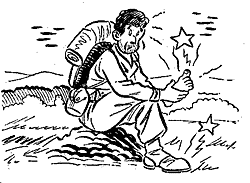|
||
|
||
I Ploughshares to Swords |
||
| REVEILLE ON THE MORNING of November 25, 1940 was
a special occasion in the 141st Infantry Regiment, Texas National Guard. At San Antonio,
Texas, location of the Headquarters, long lines of intent men, outfitted in 0. D. shirts,
battered campaign hats and khaki breeches, listened to the reading of the President’s
Executive Order No. 8 594, which changed them from civilians to citizen soldiers in the
Army of the United States. This ceremony was repeated in various forms in other Texas
towns where units of the regiment were located: El Paso, San Benito, Robstown, Waelder,
Gonzales, Lockhart and Luling. The regiment ordered into Federal Service for one year as
part of the 36th (Texas) Division. The legal transition that morning was simple and short.
The practical transition demanded more time. Some 40 days after the Executive Order was read, all units of the regiment had completed the move from the various rendezvous points to their first permanent station, Camp Bowie, named after one of the great heroes of the Alamo and located approximately three miles south of Brownwood, Texas. In January, 1941, we received our share of 6,000 Selective Service men, all from Texas, which brought the 36th Division up to strength. At this time our Mobilization Training Program began, proceeding along with the building of the Camp. Here commenced the long and never ending training that found us five years, five countries and seven victorious campaigns later making a lethal thrust into the heart of a crumbling German army in the Austrian Tyrol. The training developed into a familiar routine: basic training, squad training, platoon exercises, company, battalion, regimental and division exercises culminating in field maneuvers of Corps and higher echelons of command. Then our trained men were selected for replacements to train more recently activated units. Many others left for Officer Candidate Schools, filling the constantly growing need for more and more officers in other units. New replacements came in to fill the gaps and the training began all over again. We were performing essential duties in the great expansion of our Armed Forces. The efforts we made had the same familiar surroundings — the plains and woods of the Texas maneuver areas, the wind and the rain, the mud and the cold, the dust and the heat; it was here that we bent ourselves to the task of acquiring skill in the art of warfare. The year, 1941, was known as "The Parade of the Wooden Soldiers". The Nation, on the very edge of the greatest war known to history, was unprepared for war. Everything was simulated. The "enemy" was "supposed". The guns were wooden. Only the spirit and enthusiasm of the officers and men was genuine. After the capitulation of France, a poll of national opinion found that a majority of the nation favored more aid to Britain; in the homeland of the Alamo Regiment the people were ready to fight, and we were saying, "To Hell with Hitler." In July, 1941, came the Louisiana Maneuvers, with the greatest concentration of troops since World War I. Here the Third Army matched recently acquired skills with the First Army. Here was Shreveport, "The Battle of the Hotel"; Leesville, "The skirmish at the Longhorn Bar"; and Lake Charles, a real Gulf hurricane. All of these were mixed in memory with forced marches, dust and heat, mosquitoes and chigger bites, long dusty columns of trucks as far as the eye could see, shirts wet and caked with dust, and tired feet. Always the tired feet, and always the rousing commands of Sergeants.
The threat of open hostilities became increasingly apparent. Our original year of active service was extended. Pearl Harbor ... December 7, 1941, the sobering news added a new intentness to all training. We abandoned the schedule which included latrine screen pitching and went to the battle itself for lessons. This was war. All training was to have the realism of war.
|
||
Copyright © 1945, 1998 141st Infantry Regiment
Association. |

 We
came out of it with the strength of a newly coiled spring. In fact, some of the spring
uncoiled at a bivouac site on the way back to Camp Bowie and we had to pay for damages
done to private property while celebrating our maneuver victories.
We
came out of it with the strength of a newly coiled spring. In fact, some of the spring
uncoiled at a bivouac site on the way back to Camp Bowie and we had to pay for damages
done to private property while celebrating our maneuver victories.